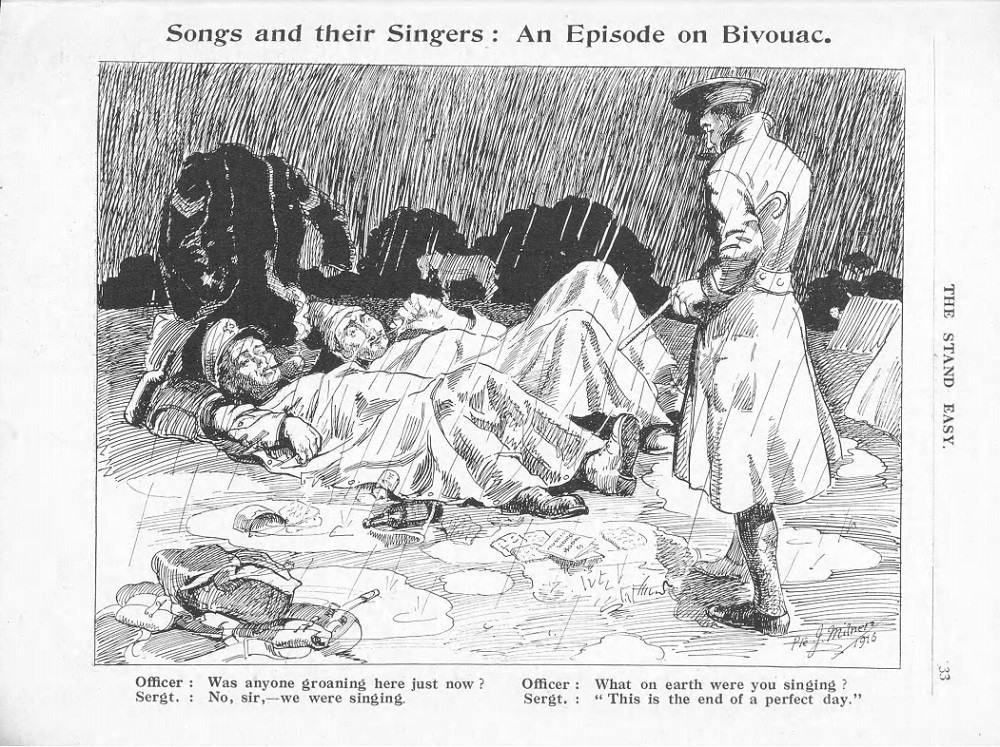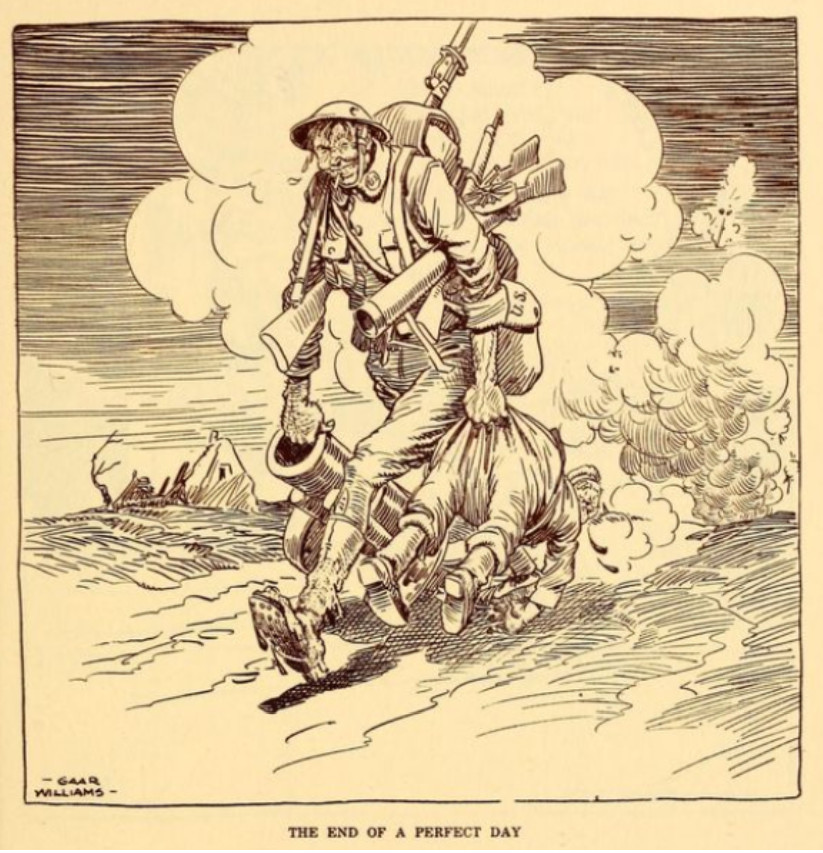Carrie Jacobs-Bond’s “A Perfect Day,” often hailed as a profoundly overlooked song of the 20th century, became an unexpected anthem during World War I. Published in 1910, years before the war erupted, its initial moment seemed to have passed. Yet, throughout the war years, no song resonated more deeply with Allied troops and the popular culture of both the United States and the British Empire. Surpassing even George M. Cohan’s patriotic “Over There,” the Powell brothers’ optimistic “Pack Up Your Troubles,” or the marching tune “It’s a Long, Long Way to Tipperary,” the poignant melody and heartfelt words of “The End of a Perfect Day” (as it was also known) provided solace to soldiers on the front lines and their families back home.
 Cartoon depicting soldiers in bivouac, referencing "A Perfect Day."
Cartoon depicting soldiers in bivouac, referencing "A Perfect Day."
An Unlikely Wartime Hit: The Rise of “A Perfect Day”
The commercial success of “A Perfect Day” was undeniable. Sheet music sales experienced rapid growth and maintained remarkable consistency year after year. Between February 1914 and January 1915 alone, the song sold over one million copies of sheet music. By the war’s end, sales exceeded four million, fueled by over fifty recordings from renowned singers such as Frances Alda, Clara Butt, and Evan Williams. No other song from this era achieved such impressive figures, solidifying its status as a truly Perfect Song for the time.
Newspapers across the United States and Great Britain documented widespread public performances of “A Perfect Day” throughout the war. British press reports from these years detail the song’s consistent popularity across the nation, frequently requested as a beloved encore. In November 1916 alone, newspapers recorded 98 performances, followed by another 108 in December. Many of these events were fundraisers, hospital concerts for wounded soldiers, and gatherings in churches, particularly Non-Conformist meetings like Congregationalist Pleasant Sunday Afternoons. During the summer months, a band arrangement featuring a solo trumpet became a park concert staple, a tradition that continues in some places today.
Why “A Perfect Day” Resonated Deeply
“A Perfect Day,” by Highley Colliery Brass Band, Bewdley, UK, 2015. Soloist Joe Hill.
During the war, “A Perfect Day” held immense emotional significance for soldiers. It served as a powerful emotional bridge, transporting them back to the tranquility of home, evoking memories of friends lost in battle, or simply expressing gratitude for surviving another day amidst conflict. In the post-war years, the song served as a poignant reminder of fallen comrades resting in war cemeteries across France and Flanders. The song’s title became so ingrained in the cultural consciousness that it was used as a caption in countless cartoons of the era, and inspired George Wotherspoon to create a painting titled after the ballad. Even Gaar Williams, a nationally syndicated cartoonist, incorporated the song’s sentiment into his iconic image of a triumphant American soldier for the Indianapolis News, which appeared on July 20, 1918, beneath the headline “Huns, Repulsed, Are Retiring Across the Marne.”
 Gaar Williams cartoon titled "The End of a Perfect Day," depicting a triumphant soldier.
Gaar Williams cartoon titled "The End of a Perfect Day," depicting a triumphant soldier.
Contemporary Understanding of the Song’s Power
The sources of “A Perfect Day’s” emotional impact were recognized and discussed even during the war itself. The melody and lyrics were equally crucial, with the tune often hummed or whistled, and the words quoted in letters sent home. An Australian column, “On Books and Authors,” published in The Adelaide Register in September 1918, perfectly captured these sentiments:
There are few concert programmes from which this song is absent, either at home or close to the front line. At one of the latter, during a pause in the sing-song, the leader … announces that he will sing a solo. “What do you want?” he asks. Some cry “The perfect day,” and others ask for another song. “Show hands,” he cries; there are a few dozen for one, and some hundreds for the other, so “The perfect day” is sung. It is always a prime favourite, and the psychology of the song is a study. It enables the man to think of home, but the spirit of the piece saves them from any dull feeling of loneliness; the heart is wreathed in good feeling, sober and subdued, and, as they think of the home folks, they have no dread; all is well there as with themselves. It is not a song they want to sing so much as listen to, and when it is sung to the piano, and the soft compelling notes of the violin, a hush falls, and they listen without moving a muscle.
Soldier Testimonials: “The Inspiration of the Trenches”
Carrie Jacobs-Bond was deeply moved by the numerous letters she received from soldiers expressing their gratitude for “A Perfect Day.” One letter from a soldier in England in July 1917, exemplifies the song’s profound effect:
In England, July 10, 1917 / Mrs. Carrie Jacobs-Bond: I have often thought of writing to you about the marvelous popularity of this particular song. I mean to be perfectly candid without the slightest intention of flattering you, when I say that ‘The End of a Perfect Day’ is the most popular ballad in the army of the Allies. I heard it last winter played upon a one-string violin accompanied by several quaky voices as it came from a quarantined hut; I heard a famous London singer at the Soldiers’ Recreation hut, where thousands were; I heard a cornetist, with a woefully bad band, puff and spout his way through it and receive a tremendous encore; I heard an entire battalion, coming in from the rifle ranges, sing this number as a marching song; I heard it as a duet Sunday night in a little old tent where divine services were held for such as might come. I have used the song dozens of times by request and have always found it to be enthusiastically received. / Very truly yours, Ed Chenette (Watt, 1917).
The “Shrapnel Quartet,” a group of four blind soldiers who had sustained injuries in battle, further demonstrated the song’s impact. Instead of returning home to England, they chose to tour the front lines, using their musical talents to support the war effort. One member wrote to Mrs. Bond, stating that in the trenches and crowded hospital wards, soldiers weren’t singing upbeat, boisterous songs, but rather “the song that has become the inspiration of the trenches: ‘The End of a Perfect Day’” (Anon., 1918). A 1914 recording by the Metropolitan Quartet provides a glimpse into the sound of soldier quartets performing this perfect song.
Metropolitan Quartet, “A Perfect Day,” Edison Blue Amberol 2368. August, 1914
“A Perfect Day” Marks the War’s End
When the armistice was declared, ending World War I, celebrating soldiers and civilians repeatedly invoked the phrase “the end of a perfect day” and the song that had made it so ubiquitous. Eddie V. Rickenbacker, the celebrated American fighter pilot, concluded his diary entry for November 10, 1918, with: “Report of Kaiser’s abdication and revolution in Germany. Indeed the end of a perfect day.” Carrie Jacobs-Bond recounted an anecdote shared by her son, Fred Smith, about witnessing an impromptu performance of “A Perfect Day” in Manhattan on Armistice Day:
On November 11th, 1918, the day the Armistice was signed, my son was in New York City, standing at the head of Central Park, when four men put their arms around each other’s waists and began marching and singing A Perfect Day. My son joined them and they gathered singing men until they landed down at Madison Square with over 5,000 in that serpentine line all singing my song. When my son telegraphed me this news I said, ‘This is the end of A Perfect Day for me’ (Bond, 584).
The enduring popularity and emotional resonance of “A Perfect Day” cemented its place as more than just a song; it became a symbol of comfort, hope, and shared humanity during a time of global conflict. Its unexpected journey to wartime anthem underscores the profound power of music to unite and uplift, even in the darkest of times, making it a truly perfect song for an imperfect world.
Postcard from summer 1918.
Notes
The Highley Colliery closed in the 1960s, but the Highley Colliery Brass Band, founded in the 1890s, lives on, reborn in 1993. There is a good post on the impact of “A Perfect Day” in Australia.
Anon., “Famous Woman Composer Sings at Syracuse,” Music Leader, vol. 36 no.16 (17 Oct. 1918), 381.
Carrie Jacobs-Bond, “Music Composition as a Field for Women. From an Interview Secured Expressly for The Etude, with the Most Successful Composer of Songs of the Present Day,” Etude Magazine (Sept. 1920), 583-84.
Charles Watt, “Carrie Jacobs-Bond: An Appreciation,” Music News, vol. 9 no. 4 (2 Nov. 1917), 20-21.
